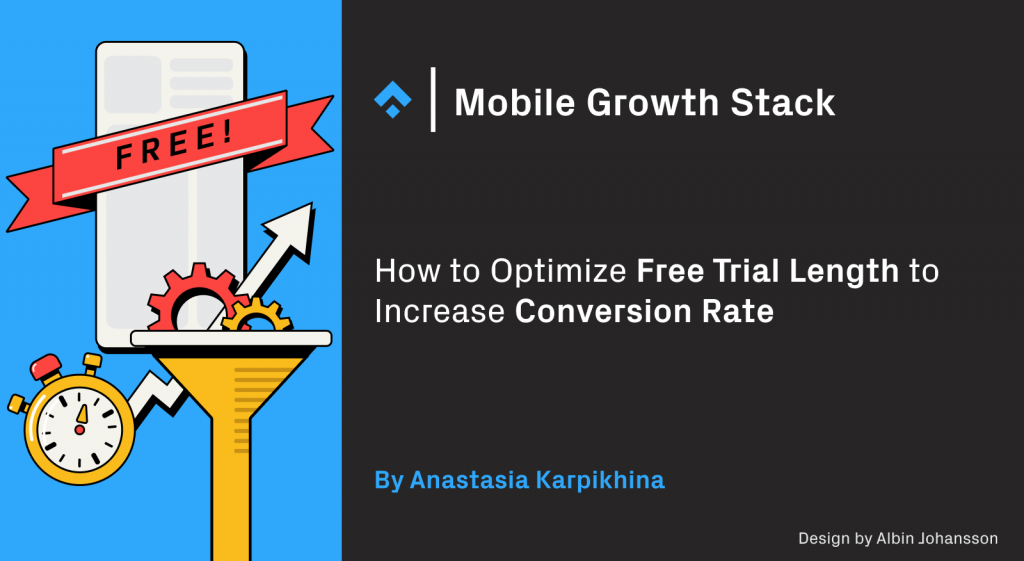
This article is part of our blog series about the Subscription Stack, a strategic framework for Subscription Optimization. You can read the full Subscription Stack here.
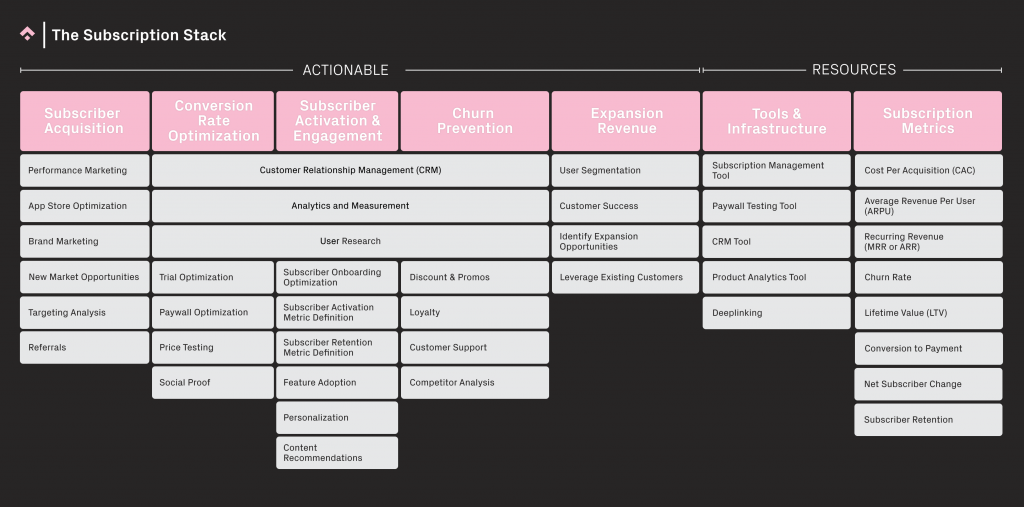
Introduction
Recently, one of the most popular topics for subscription businesses has been finding the optimal free trial length for your web or mobile products. In this article, we will try to reflect on why trial length matters, provide insightful trial length benchmarks, and explore possible trial strategy optimizations with the help of natural usage habit analysis.
An important aspect of plotting every new user’s journey is the length of the free trial offered. By choosing precisely the right time to ask your user to upgrade, you will see your conversion rate improve.
Subscription management platform RevenueCat’s dataset shows us that about 60% of apps offered a free trial experience of some kind, while (across all categories) most apps opted for the standard trial length options of four, seven, 14 or 30 days. However, it may be more optimal for your product to use a different timescale for free trials, in order to align more closely with the Natural Usage Habits of your individual user base. Natural Usage Habits are sometimes also known as Product Usage Intervals.
Different trial models explained
Free trials, as the name suggests, let people try out a product for free for a certain period of time, at the end of which users either stay and pay – or churn. During this trial period, users should be properly onboarded to the product in order to understand its value, and – even more importantly – create a habit around its main features to become a returning user.
From a time perspective, trials can be divided into freemium, reverse, and standard trials.
- Freemium models allow access to limited product features without time restrictions. To get the full functionality of your product, the user has to upgrade to a paid tier. However, according to the data, this model has the lowest Conversion Rate in comparison to others and the question of optimal trial length isn’t relevant here.
- Reverse trials give new users a time-limited free trial of paid features. At the end of the trial, they can either decide to buy or to downgrade to a fully free tier.
- Standard trials allow users to try out your product for free for a certain period of time before they have to commit to pay to continue using your product.
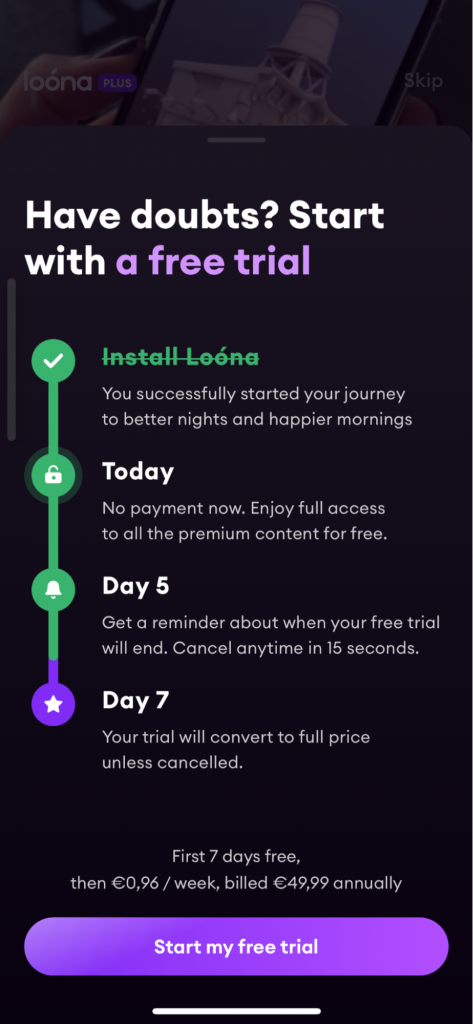
Trial length configuration and benchmarks
From a business perspective, finding the optimal trial length will improve conversion rate, simply because asking a user to upgrade at the right moment is more likely to result in conversion.
Apple allows apps to set free trial lengths from three days up to one year. Google offers even more flexibility and doesn’t have any predefined trial lengths – it’s possible to set any period from three days up to three years. Meanwhile, for desktop products, developers can set any length they wish. This flexibility means it’s really important to test different options in order to find the optimal trial length.
According to Statista, a three day-trial is the most common length used by 32% of mobile apps, followed by a seven day trial (31%). Indeed, having shorter trial lengths has its advantages. To test trial length durations, it’s crucial to track two metrics – CAC (Customer Acquisition Cost) and LTV (Lifetime Value).
Shorter trial periods (seven to fourteen days) can help keep the CAC down, due to less resources required to support these free users during the trial period, while longer trials are likely to result in a higher costs.
The trial offer from the Balance app, which provides guided meditation, is a good example of what cost might actually be!
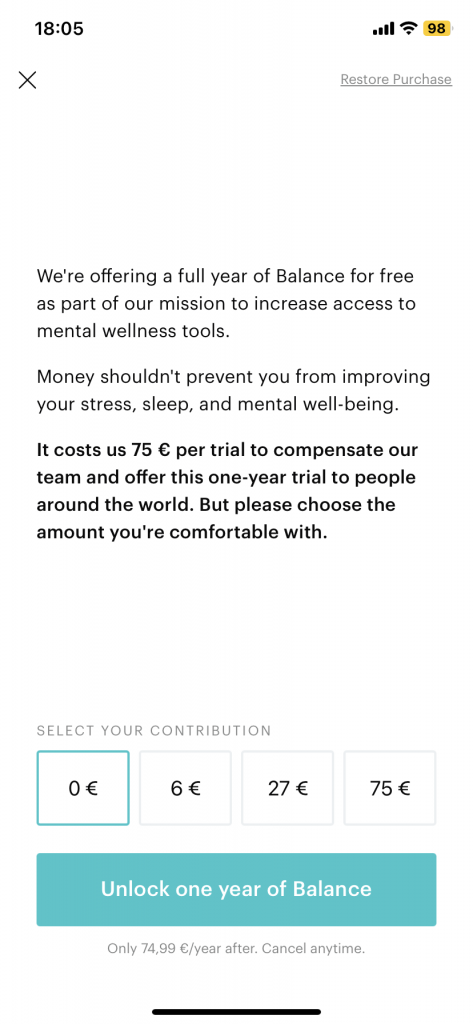
Balance’s one year free trial allows users to choose the contribution themselves, with 75 EUR (the cost of the trial per user) being the highest amount a user can pay. This is an eye-catching offer, and commendable given Balance’s stated mission to improve their user base’s mental health. However, it also raises questions as to how profitable this acquisition strategy is long-term, in the competitive category of health and fitness apps, which will all depend on the LTV of Balance’s users.
Ensuring a balance between habit-forming and CAC
While the LTV and CAC should underpin your decision on trial length, if your product is technically complex, seven to fourteen days may be insufficient for users to reach the ‘a-ha’ moment and receive full value. You may therefore be neglecting those users who could bring high LTV later on.
For example, apps used for planning, budgeting or investing often have a long registration process, after which the user has to pass internal security checks and KYC (know-your-customer) processed being able to configure the app and finally start to receive value. Hootsuite, a social media management product, offers a 30 day trial as the product not only allows users to schedule posts across various social media channels, but also offers analytics and benchmarks to track performance, which require time to be collected.

At Phiture, we have often observed that apps with trial lengths of three or seven days are often used on a monthly basis rather than daily or weekly. In such cases, users don’t have enough time to experience the value proposition of the app and develop a habit, although the CAC is likely to be lower. For example, Digital Planner currently offers a three day trial. This is a very short period of time to allow users to create to-do lists or habit trackers.
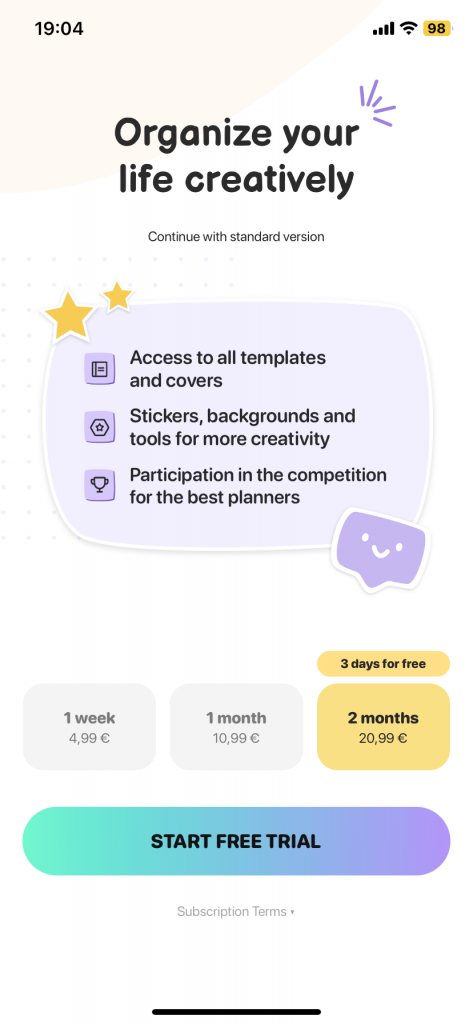
In these cases, researching and reflecting upon your product’s Natural Usage Frequencies or Habits (NUH) can be advantageous.
AI-Powered Trial Experimentation
The optimization of free trial length is no longer limited to manual A/B testing. In 2025, subscription teams will rely more on AI-assisted experimentation frameworks that simulate conversion and retention outcomes before deployment.
Tools like RevenueCat Experiments, Qonversion Predict, and Amplitude Experiment now integrate directly with subscription data, enabling marketers to test trial lengths dynamically across cohorts and geographies. These platforms utilize predictive LTV modeling to identify which user segments are likely to convert sooner and which require more time to see value.
For example, users who reach a product’s “aha moment” (such as completing a key feature or connecting a payment method) within their first two sessions can automatically be offered a 7-day trial. In contrast, less-engaged users may receive a 14-day or extended offer to encourage deeper exploration.
This AI-driven approach replaces guesswork with probabilistic insight, allowing teams to balance conversion efficiency and user satisfaction in real-time.
In short, the optimal trial length is no longer universal; it’s adaptive. AI-powered testing enables you to find the right duration for each behavioral pattern, not just the average user.
Natural Usage Habits
The Natural Usage Habit (also called Product Usage Interval) informs you of how frequently users naturally use an app, game, or other product. It can typically be calculated in your analytics tool of choice.
Of course, there is no universal interval for natural app usage, as each app has different product offerings with different usage patterns. For example, users might check a weather app every day – while e-learning, health, or utility apps could be used on a weekly or even monthly cadence. Additionally, seasonal apps (for example, sports league apps) will show different usage patterns across the year.
CRM and Product Managers are increasingly trying to pinpoint exact usage intervals in order to plan appropriate engagement strategies. It can be tempting to assume what the Natural Usage Habits of your user base are, however, any such hypotheses should always be backed up with data to reach sound conclusions.
Furthermore, some apps will also have multiple usage habits depending on what need the app is solving. Conducting proper user research into your individual Natural Usage Habits is really important here.
Segmentation of different usage patterns
It’s important to bear in mind that a Natural Usage Habits analysis won’t contain all the answers to inform a free trial strategy, but this research on how often and frequently a user needs to perform your core event before a habit is formed can help make a better-informed decision about trial length.
A segmentation approach based on further user research can also uncover interesting insights, by identifying ‘power users’ and their reasons to use the app. For more information on how to conduct this user segmentation, check out this article here.
For instance, with a meditation app, some users may use this app purely for reducing sleep problems, resulting in a daily usage habit, while other users who focus more on dealing with anxiety problems may open the app only occasionally.
It would therefore be beneficial to also offer different trial lengths to different user personas, in this case a shorter trial for users interested in solving sleep problems, and a longer trial for those users looking to become less anxious.
Optimizing free trial strategy using usage patterns data
It’s not always manageable to change trial length due to competing business and product priorities. However, once you’ve calculated the Natural Usage Habits for different user segments, you can optimize your trial strategy as well as use CRM to personalize the user’s trial experience and potentially reduce conversion friction.
The ultimate goal here is to increase the Conversion Rate, however, there’s no unified metric for how many trial days a user needs in order to convert, varying case by case. Recent data from RevenueCat shows that shorter trials (four days or less) convert by 30% worse than longer ones (four days or more). However, according to Recurly (a subscription management platform), after four days there is no big difference between conversion rates of different types of trials, whether seven days, 14 days, 30 or 60+ days.
This doesn’t mean you should always opt for a trial length of more than four days – each app should still study its Natural Usage Habit accordingly (and many already do). Based on these patterns, you can then further optimize trial length.
Boosting trial conversions via personalization and segmentation
One of the best ways to boost trial conversions is to personalize your trial offer based on user segments. Data from RevenueCat states that for apps with trials, on average only 3.7% of app downloaders start a trial, so some users might need an extra nudge to start a trial in the first place. In such cases, a sense of urgency is necessary, for instance by using a countdown as Speech Blubbs does.
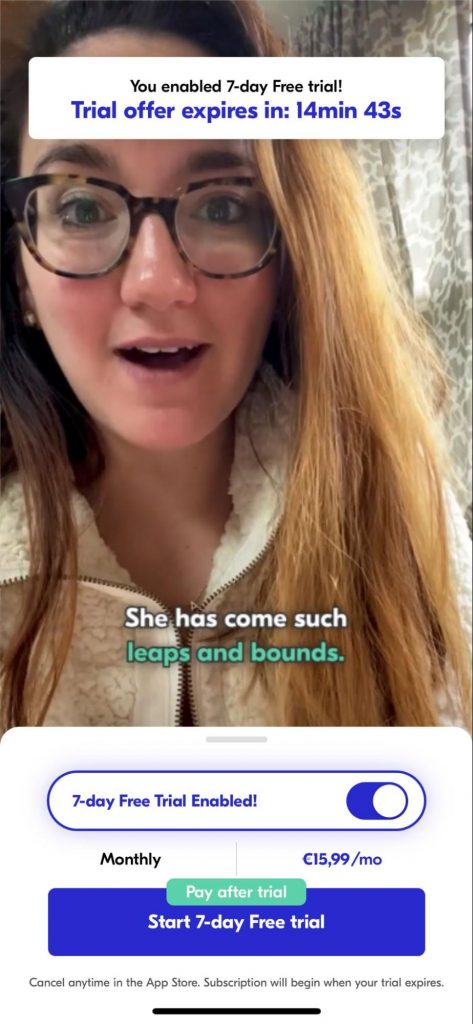
As previously mentioned, the habits of actively engaged users may differ drastically from the habits of casual users, who are altogether less engaged with your product. Once you‘ve calculated the usage habits of all cohorts, you can apply these data insights to target all new users undertaking a free trial as soon as possible with personalized CRM and incentives to upgrade.
CRM strategies for ‘power users’
The focus here is to create a strategy to convert your most active ‘power users’ from free to paid users as early as possible. On average, only 38% of users who start a trial become paid subscribers, so it’s crucial to use the right moment to emphasize the exclusivity of the early conversion to your most loyal users. To facilitate this, messages that promote any additional perks of becoming a premium user earlier are vital, as are social proofs highlighting the offer’s exclusivity.
CRM strategies for ‘regular users’
Of course, CRM aimed at ‘regular users’ should also be personalized as much as possible, although less data provides less insights to act upon. A strategy that focuses on ‘regular users’ aims to activate less-engaged trial users and increase their likelihood to convert. To ensure effectiveness of this initiative, it’s worth investing in tracking those users’ activity during the very first days (and even hours) to see how intensely they are adopting paid features. Reminders about trial endings could serve well here and help to build trust and increase transparency, like Harvest (time tracking tool) does.
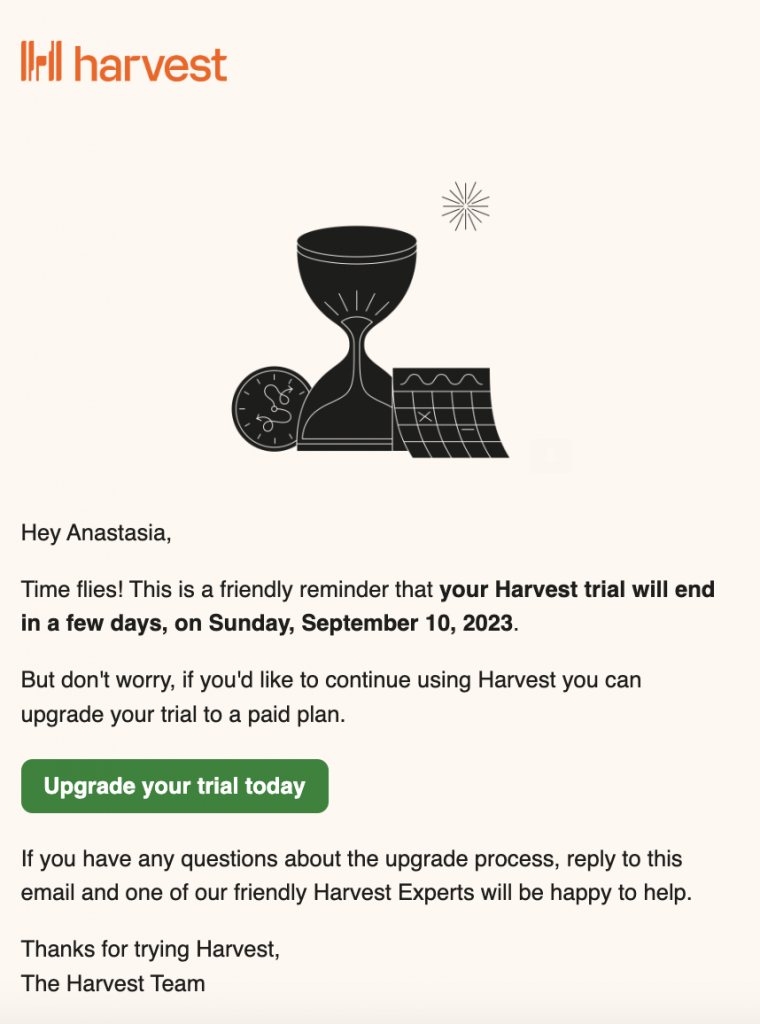
Win-back strategies
The last strategy (and often the least prioritized) is a win-back strategy for trial cancellations. A report from Qonversion says that 39% of free trialists are canceling their trial in the first 24 hours, a huge number of users. Offering a trial extension for a certain number of days during the cancellation flow could help give your users a second chance to explore the product. ClassPass, the sports booking app does this well by sending a nudge to users, offering to downgrade their membership and even discounting existing memberships.
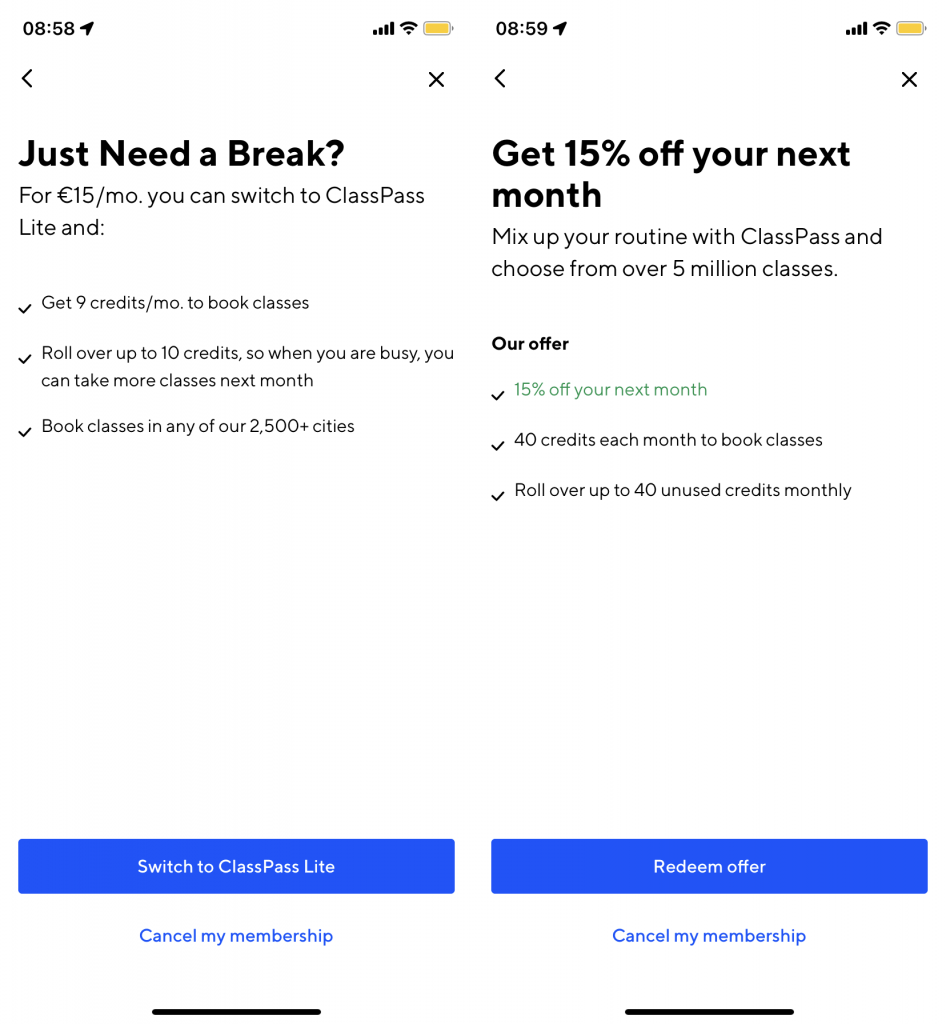
Wrap-Up
In conclusion, there is no definitive answer on how long a free trial should last. Your best trial length depends on many factors, starting with business objectives. However, optimizing your trial length will very likely result in an increased Conversion Rate to paid user. Analyzing Natural Usage Habits will provide insights into how different segments of users are using your app — let these patterns inform your free trial lengths.
At the same time, various CRM strategies can address friction during the trial without even changing the length itself, and in itself improve conversion. Ultimately, the key is to find the right balance between a trial that is long enough for the users to form a habit, and a trial that is short enough to ensure business profitability.
Before you go
- Need advice on the optimal trial lengths for your product in order to maximize conversion? Reach out to our team here.
- For the full overview of the Subscription Stack by Alice Muir, you can download the pdf here.
- NPS is a metric, used by many organizations, that calculates overall user satisfaction by asking users to rate the product between a score of zero to ten. Learn how to implement NPS here.
- The first in Alice Muir’s Subscription Stack blog series is about User Acquisition. This is a must read, acquisition preempts Conversion Rate Optimization.
Sources and further reading
- https://www.appflow.ai/blog/improve-trial-conversion
- https://tips.ariyh.com/p/optimal-free-trial-length
- Reforge
- https://www.linkedin.com/posts/alicemuir_revenuecat-across-10000-mobile-apps-longer-activity-7013601329822486528-imZD
- https://www.linkedin.com/feed/update/urn:li:activity:7013192791568654336/
- https://www.revenuecat.com/blog/growth/app-trial-conversion-rate-insights/
- https://fastspring.com/blog/8-strategies-for-converting-free-trials-users-into-paying-customers/
- https://phiture.com/mobilegrowthstack/natural-usage-habits-choosing-your-engagement-metric-a158438962c3/
- https://rocketium.com/academy/how-to-engage-users-based-on-frequency-of-mobile-app-usage/
- https://www.thinkwithgoogle.com/marketing-strategies/app-and-mobile/app-usage-frequency-by-week/
- https://www.statista.com/statistics/1176951/frequency-of-use-among-whatsapp-users-in-germany/
- https://www.appcues.com/blog/free-to-paid-conversion-strategies
- https://www.toplyne.io/blog/free-to-paid-conversion-strategy
- https://go.recurly.com/rs/439-LSC-903/images/FINAL-rp-2023-01-state-of-subs-report.pdf
- https://encharge.io/perfect-saas-trial-length












